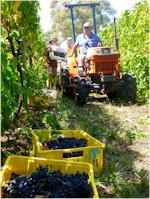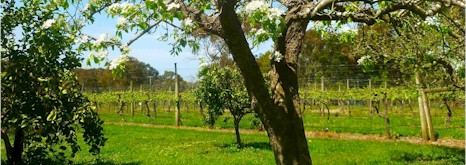


Merricks Estate label is an 1821 lithograph by Louis de Sainson entitled Habitation de Pecheurs de Phoques au Port Western. The earliest printed image of Victoria, dated two years before the founding of Melbourne. It depicts a sealers camp between Merricks and Point Leo beach. The vineyard covers more than 3 ha and production varies between 1500 and 3000 cases, according to the season. Seasons can vary dramatically. While the location is magnificent, it comes with often difficult weather, especially in late spring and early summer when the vines are flowering and the new leaves offer little protection from gale-force winds and blinding rain. In such conditions, viticulture is crucial.

Merricks Estate uses the Scott Henry trellising system, which maximizes the light and sum available to the fruit and opens out the canopy of leaves. The leaves are the vine's solar collecters and the way they are now trellised provides greater opportunity for photosynthesis for fruit ripeness and flavour during the long ripening season. In the extended ripening before picking in April and May, flavours are concentrated and the varietal characteristics of grapes are intensified. There is tremendous diversity within each block of varietal grapes at Merricks Estate. This can be attributed to the magnificence of Mornington's mesoclimes, the highly favourable terroirs and a manifest of opportune clones.
Merricks Estate Shiraz was recognized as an exceptional wine from its earliest release. The 1984 Shiraz was named by England's prestigious Decanter magazine as one of the best wines of 1985, and was described as a wondrously spicy/peppery wine which is, at the same time hauntingly delicate
At Merricks Estate the most elusive grape, Pinot Noir, has produced superb burgundian style wines but tantalizingly low yields. It was therefore gratifying when the 1997 Pinot Noir, the first vintage to meet Royal Melbourne Show volume requirements, was awarded the trophy for Best Pinot Noir.
In a move towards crafting vintages which are more articulate of Mornington, some of the older Cabernet vines were replaced by Pinot Noir. Clones include the M4V2 (Pommard) and the Abel. The old French Pommard clone celebrated for its darker fruit, structure, density, chewy texture and sweeter nose. The Abel also originated from France adds a more savoury characteristic to the wine. Additional plantings of the auspicious MV6 have also served well. The vineyad team are always very excited about these additional clones at harvest time as they look forward to better vintages offering wines of greater complexity. The small amount of older Merlot vines have also been removed and replaced with a half acre of Chardonnay.

























